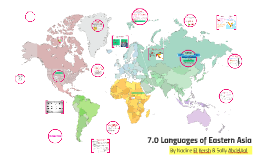Oracle Presentation
Transcript: Includes 92 languages found in Southern China & Southeast Asia. Starter... 7.0 Languages of Eastern Asia I S O L A T I N G - Some Sino- Tibetan languages (especially Sinitic branch) - Use pitch to distinguish grammatical meaning Example: in Mandarin, most syllables carry their own tone and are differentiated only by tone. M O R P H O L O G Y Some Scholars, argued that these 2 families are not related at all: there's an absence of regular sound correspondence, in morphology, and evidence that the families have been borrowed from Chinese Vietnam Sinitic (Chinese) Influence of the European Colonization: Tones in Thai: However, some languages in the family are not tonal at all like Mongolian & Khmer. Vietnamese is considered the biggest Austro-Asiatic language with 66 million speakers. Eastern Austro-Asiatic (Mon-Khmer) By Nadine El Kersh & Sally AbdelAal 7.2 Austro-Asiatic languages Mon was a historically important languages and played an important role in the development in Thai and Burmese cultures. It is still spoken in delta area to the east of Yankon. Best known members of the Tai-Kadai family are closely related and mutually intelligible and both are south western groupings: - At first, Vietnamese exhibited some features common to other languages in the Austro-Asiatic family (Non Isolating Morphology and a richer set of constant clusters). But now, it developed: Isolating Morphology Classifier System A tonal System Tonal Systems: Romanized writing system French replaced chinese as the official language, education, and governments. Vietnamese borrowed many french words Example: ‘Dȃm’ from ‘madame’. Resulted to the development of grammatical characteristics in the Thai language through diffusion of the Chinese language. - In isolating languages, words are composed of single morphemes. Also, grammatical relations such as Subject & Object are not expressed morphologically, but through word order. Example: Mandarin (SVO) - Burmese (SOV) Instead, they determine if the sentence is a question by its tone, but using no question mark or wh- words! Vocab: Sino-Vietnamese Continued.. THANK YOU! Sino-Tibetan Languages It means that they don't have wh- questions; What? Where? When? it consists of 147 languages spoken in: Vietnam, Cambodia, Malaysia, and NicoBar Islands. - Contains only 14 languages. - One of the languges is Mandarin Chinese (spoken by 840 million speakers) - Smaller chinese languages have tens of millions of speakers: Eg. Wu Chinese has over 77 million speakers, YUE has 52 million speakers. - These languages are not uniform & have many dialects. Ex: Madarin Chinese has 4 dialect groups: Northern, North Western, South Western, & Eastern. - Despite not being Mutually Intelligible, Chinese languages are considered the same. - A chinese character will have a very different sound from language to language, but the same meaning There's a detailed recorded history only for Vietnamese,Khmer, and Mon. 7.3 Tai-Kadai Languages - Morphology - Thai is an a isolating language, its nouns are not marked for gender, number cases, tense, or mood. These are expressed by separate, free standing words. LAOS Lao & Thai have similar morphology using free standing words instead of bound morphemes to express grammatical notions. They are both SVO languages. Syntax: Western Austro-Asiatic (Munda) - It includes 169 Languages. - Spoken from eastern India across Vietnam and down to Nicobar Islands and Malaysia. - Spoken by 3 million people in Laos especially in Mekong River Valley. - There is closely related linguistic Variety between both sub families. Laos HOWEVER - The Chinese writing system was imported and used in a modified form to write vietnamese. What is wh-in-situ? So far, we have considered the morphological and tonal systems of the Sino-Tibetan family, but what about its syntax? In addition, we should note 3 other types of verbal particles in Thai: - Video Other Scholars argue that there is regular sound correspondence as well as grammar similarities. Asutro-Asiatic languages are spoken over non contiguous chunks of territory. Why? Laos Eastern Austro-Asiatic Languages - 30-40% of vietnamese vocabulary came form china. Influence of China: chinese came to pre dominate politically in vietnam and remain the governing power for nearly 10 centuries. Chinese was for long the language of literature and government as well as the primary writing language in Vietnam. - 5 Tones in Thai, 6 in Lao. Western Austro-Asiatic languages ( Munda languages) Interesting fact: Some Sino-Tibetan language use the 'wh-in-situ' phenomenon Myanmar There is 1 main subfamily of the Tai-Kadai family: Kam-Tai (includes 76 languages) & 2 other: Kadai (14 languages spoken in Vietnam and China) & Hlai (2 languages spoken in China). Continued.. influenced by indo-European ( indic) and Dravidian languages exhibit many characteristics that make them dissimilar from vietnamese and other Mon khmer languages they are agglutinative ( influenced by Dravidian

















